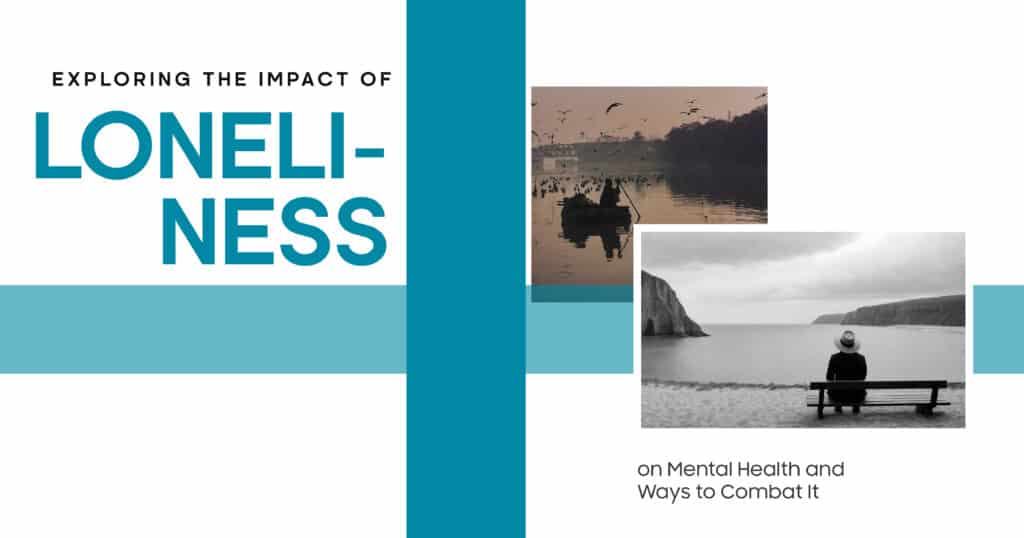Loneliness—it’s a term that’s tossed around often, but its impact on mental health is profound and far-reaching. We might think of loneliness as just a feeling of being alone, but it’s much more complex.
Essential Takeaways
- Loneliness Affects Mental Health: It’s linked to depression, anxiety, and cognitive decline. Addressing loneliness is crucial for better mental well-being.
- Effective Connection Strategies: Strengthening social ties, boosting self-esteem, and engaging in meaningful activities can help combat loneliness.
- Community and Professional Support: Utilizing community resources and professional help is vital in overcoming loneliness. Promoting supportive environments also fosters a more connected community.
Loneliness is a deeply emotional experience that can affect anyone, whether they’re surrounded by people or alone. In this blog post, we’ll explore what loneliness really means, how it affects mental health, and, most importantly, how you can tackle it effectively.
What Is Loneliness?
Defining Loneliness
Loneliness isn’t just about being alone; it’s the feeling of not having the social connections you desire. It’s a gap between the social relationships you have and the ones you want. You might be surrounded by people and still feel lonely if you don’t feel truly connected or understood. Conversely, someone living alone might not feel lonely if they have meaningful relationships and social interactions.
Loneliness is often categorized into two types:
- Emotional Loneliness: This arises when someone lacks close, intimate relationships. It’s the kind of loneliness you might feel when you’re missing a close friend or partner who understands and supports you deeply.
- Social Loneliness occurs when someone feels isolated from a broader social network. Even if you have close friends, if you lack a wider circle of acquaintances or community, you might experience social loneliness.
Types of Loneliness
Loneliness can manifest in various ways:
- Transient Loneliness: Short-term feelings of loneliness, often linked to temporary circumstances or life changes.
- Chronic Loneliness: Persistent loneliness that lasts for a long time, often due to ongoing issues with social connections or personal circumstances.
Understanding the different types of loneliness helps us to better address and manage these feelings.
The Psychological Impact of Loneliness
Mental Health Disorders Linked to Loneliness
Loneliness is not just an emotional burden; it can have serious implications for mental health. Here’s how loneliness can affect various aspects of mental well-being:
- Depression: Loneliness can intensify feelings of sadness and hopelessness. Persistent loneliness often contributes to or exacerbates depression, leading to a cycle of emotional distress and isolation.
- Anxiety: The stress and worry associated with loneliness can lead to heightened anxiety. Individuals may feel overwhelmed by the absence of social support, which can increase their anxiety levels.
- Cognitive Decline: Studies have shown that chronic loneliness can impair cognitive functions. Loneliness has been linked to a higher risk of cognitive decline and neurodegenerative diseases like Alzheimer’s.
The Loneliness-Stress Connection
Loneliness triggers the body’s stress response, leading to increased levels of cortisol, the stress hormone. Chronic stress from loneliness can contribute to physical health problems like cardiovascular issues and weakened immune function. The constant state of stress can also exacerbate mental health problems, creating a vicious cycle.
Understanding the connection between loneliness and stress is crucial for developing effective strategies to combat both issues simultaneously.
Understanding the Causes of Loneliness
Social Factors
Loneliness often stems from various social factors:
- Technology and Social Media: While technology connects us in many ways, it can also create feelings of isolation. Social media can contribute to loneliness by fostering superficial connections and promoting unrealistic comparisons with others.
- Work and Lifestyle Changes: Relocations, job changes, or lifestyle transitions can disrupt existing social networks. These changes can lead to feelings of isolation as individuals struggle to rebuild their social circles.
Personal Factors
Personal factors play a significant role in loneliness:
- Self-Esteem: Low self-esteem can hinder one’s ability to form and maintain meaningful relationships. Individuals with poor self-image may struggle with feelings of worthlessness and isolation.
- Mental Health Conditions: Pre-existing mental health issues can exacerbate feelings of loneliness. For example, social anxiety or depression can make it more challenging to connect with others and maintain relationships.
Age and Loneliness
Loneliness affects people of all ages, but it can manifest differently across different life stages:
- Elderly Population: Seniors often face loneliness due to the loss of peers, reduced mobility, and limited social interactions. This demographic may experience significant social isolation as they age.
- Young Adults: Young people may encounter loneliness during transitional life stages, such as moving to a new city for work or starting college. The shifting social dynamics during these periods can lead to feelings of isolation.
Strategies to Combat Loneliness
Building Stronger Social Connections
Strengthening social connections can significantly alleviate feelings of loneliness:
- Reconnect with Old Friends: Sometimes, reaching out to friends from the past can help rebuild meaningful relationships. A simple phone call or message can rekindle old connections.
- Join Clubs or Groups: Engaging in activities or clubs that interest you can provide opportunities to meet like-minded individuals. Whether it’s a book club, sports team, or hobby group, shared interests can foster new friendships.
Improving Self-Esteem
Improving self-esteem can help address loneliness by boosting confidence and social interactions:
- Positive Self-Talk: Practice affirmations and challenge negative self-beliefs. A positive self-image can make it easier to connect with others and engage in social activities.
- Set Achievable Goals: To build confidence, focus on setting and achieving small, manageable goals. Success in these areas can contribute to a greater sense of self-worth and reduce feelings of loneliness.
Enhancing Mental Health
Addressing mental health issues can also help combat loneliness:
- Therapy and Counseling: Professional support can help address underlying issues contributing to loneliness. Therapy can provide strategies for managing emotions and improving social skills.
- Mindfulness and Meditation: Practicing mindfulness and meditation can reduce stress and enhance emotional resilience. These techniques can help individuals manage feelings of loneliness more effectively.
Leveraging Technology Positively
While technology can contribute to loneliness, it can also be used to foster connections:
- Online Communities: Participate in supportive online groups and forums related to your interests. Online communities can provide a sense of belonging and connection.
- Virtual Meetups: Use video calls and virtual events to stay connected with friends and family. Virtual interactions can help maintain relationships, especially when in-person meetings are challenging.
Engaging in Meaningful Activities
Engaging in activities that provide a sense of purpose can reduce loneliness:
- Volunteer Work: Volunteering offers opportunities to help others and build meaningful connections. It can provide a sense of purpose and reduce feelings of isolation.
- Hobbies and Interests: Pursue activities that you are passionate about. Engaging in hobbies can bring joy and create opportunities to meet others with similar interests.
The Role of Community Support
Community Programs and Services
Community support plays a crucial role in combating loneliness:
- Local Support Groups: Find local support groups that address loneliness and mental health. These groups provide a space for individuals to share experiences and receive support.
- Public Resources: Use community resources such as counseling services, social events, and wellness programs. These can offer valuable support and opportunities for connection.
Creating Supportive Environments
Creating inclusive and supportive environments is essential for reducing loneliness:
- Inclusive Spaces: Advocate for and participate in creating inclusive environments in your community. Ensure that spaces are welcoming and accessible to individuals from diverse backgrounds.
- Promoting Awareness: Educate others about the impact of loneliness and the importance of social connections. Raising awareness can help foster a more supportive and understanding community.
Conclusion
Loneliness is a profound and multifaceted issue that significantly impacts mental health. It’s not just about being alone; it’s about feeling disconnected from others and struggling with the emotional toll of isolation. By understanding the nature of loneliness, its impact on mental health, and implementing strategies to address it, we can work towards a more connected and fulfilling life.
Call to Action: If you or someone you know is struggling with loneliness, take action today. Reach out to local support resources, engage in activities that foster social connections, and consider seeking professional help if needed. Your journey to overcoming loneliness and improving mental health starts with taking proactive steps. Contact us for more information on available resources and support in your area.
FAQs
1. What are the most common signs of loneliness?
Common signs of loneliness include persistent sadness, lack of motivation, withdrawal from social activities, and difficulties forming new relationships. Individuals may also experience changes in sleep patterns, appetite, and overall mood.
2. How can technology contribute to loneliness?
While technology can connect us virtually, it can also lead to feelings of isolation by creating a false sense of connection. Social media often promotes unrealistic comparisons and superficial interactions, exacerbating feelings of loneliness and inadequacy.
3. Are there specific therapies that help with loneliness?
Yes, therapies such as Cognitive Behavioral Therapy (CBT) and Interpersonal Therapy (IPT) can help address the emotional and psychological aspects of loneliness. These therapies focus on changing negative thought patterns and improving social skills, respectively.
4. How can I support a friend who is experiencing loneliness?
Offer a listening ear and validate their feelings without judgment. Encourage them to engage in social activities or join support groups. Helping them connect with professional resources, if needed, can also provide valuable support.
5. What are some practical ways to build new social connections?
Practical ways to build new social connections include joining local clubs or interest groups, attending community events, participating in online forums related to your interests, and reaching out to people with similar hobbies or passions.












